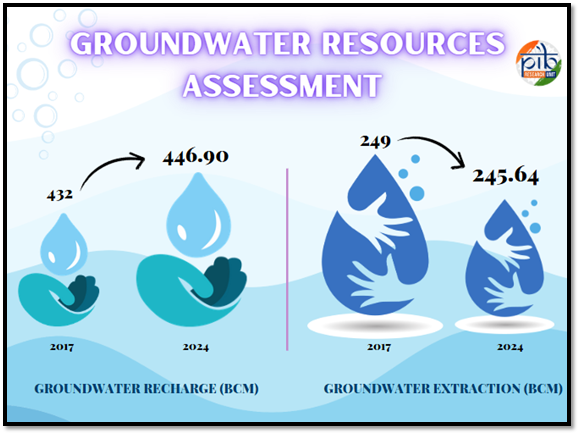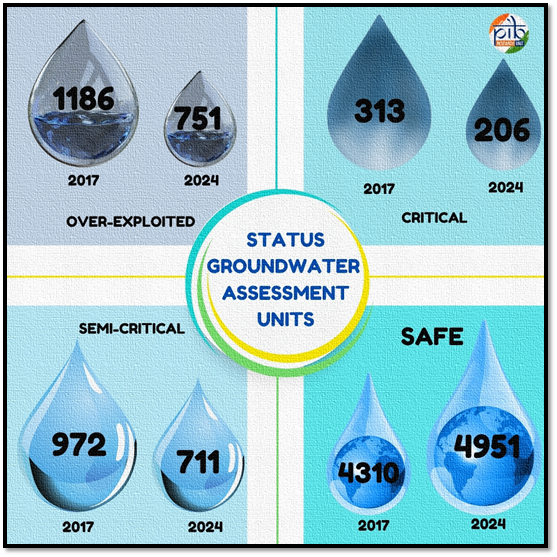India’s Groundwater Revival
A single drop of water journeys across the land filtering through rocks and sand to become the invaluable resource we rely on—clean groundwater. This essential source supports life, fuels agricultural productivity and secures water for millions. In 2024, total annual groundwater recharge experienced a significant increase of 15 BCM (Billion Cubic Meters), while extraction decreased by 3 BCM compared to the 2017 assessment. This progress underscores the importance of understanding groundwater's availability, usage, and the challenges ahead.
Country’s Groundwater Resources[2]
The Central Ground Water Board (CGWB), in collaboration with State Groundwater Departments, releases annual reports on groundwater resources. The 'National Compilation on Dynamic Ground Water Resources of India, 2024' offers a comprehensive state-wise overview, serving as a foundation for effective policies and management strategies. According to the latest report, the total annual groundwater recharge is assessed at 446.90 Billion Cubic Meters (BCM), with an extractable resource of 406.19 BCM and an annual extraction of 245.64 BCM. The report highlights increased recharge, mainly due to water bodies, tanks, and conservation structures and shows improvements in groundwater
conditions in 128 units compared to 2023.

The year 2024 has seen positive advancements in several key areas, with notable highlights including:
- Total Annual GW Recharge has increased (15 BCM) substantially and Extraction has declined (3 BCM) in 2024 from 2017 assessment.
- Recharge from Tanks, Ponds and WCS (Water Control System) has shown a consistent increase in the last five assessments. In the year 2024, it has increased by 0.39 BCM w.r.t. 2023.
- With respect to the year 2017, there is an increase of 11.36 BCM in recharge from Tanks, Ponds & WCS (from 13.98 BCM in 2017 to 25.34 BCM in 2024).
The percentage of Assessment Units under Safe Category have increased from 62.6% in 2017 to 73.4 % in 2024. The percentage of Over Exploited Assessment units have declined from 17.24 % in 2017 to 11.13 % in 2024.

Clean Groundwater: Essential for Future Generations[3]
Maintaining groundwater quality is just as crucial as its recharge for sustainable water management. Key pollutants such as Arsenic, Fluoride, Chloride, Uranium, and Nitrate pose serious health risks, either through direct toxicity or long-term exposure. Additionally, Elevated Electrical Conductivity (EC) can indicate contamination from agricultural runoff, industrial discharge, or saline intrusion, while Iron contamination may lead to gastrointestinal issues, highlighting the importance of careful water quality monitoring.
To assess the critical areas impacted by contamination, the Annual Groundwater Quality Report for 2024 offers a comprehensive analysis of groundwater quality across India, drawing insights from data collected at over 15,200 monitoring locations and 4,982 trend stations. The report emphasizes the importance of not only preserving groundwater but also ensuring its quality for effective, long-term water management.
The report further reveals that 81% of groundwater samples are suitable for irrigation, with 100% of groundwater samples from the North-Eastern states being rated "excellent" for irrigation, underscoring the favorable conditions for agriculture in the region.
Ground Water Assessment and Management Initiatives[4]
These positive outcomes are the result of collaborative efforts between state and central governments. The Government of India has launched various initiatives to preserve water and ensure its availability for future generations. Key schemes include:
- Mahatma Gandhi National Rural Employment Guarantee Scheme (MGNREGS): Includes water conservation and water harvesting structures, enhancing rural water security.
- 15th Finance Commission Grants: Provides financial assistance to states for rainwater harvesting and other water conservation activities.
- Jal Shakti Abhiyan (JSA): Launched in 2019, now in its 5th phase ("Catch the Rain" 2024), focusing on rainwater harvesting and water conservation across rural and urban districts through convergence of various schemes.
- Atal Mission for Rejuvenation and Urban Transformation (AMRUT) 2.0: Supports rainwater harvesting via stormwater drains and promotes groundwater recharge through 'Aquifer Management Plans'.
- Ministry of Housing & Urban Affairs has formulated guidelines for the States to adopt measures suitable to local conditions, such as Unified Building Bye Laws (UBBL) of Delhi, 2016, Model Building Bye Laws (MBBL), 2016 and Urban and Regional Development Plan Formulation and Implementation (URDPFI) Guidelines, 2014 with adequate focus on requirement of rainwater harvesting and water conservation measures.
- Atal Bhujal Yojana (2020): Targets water-stressed Gram Panchayats in 80 districts across 7 states, focusing on groundwater management.
- Pradhan Mantri Krishi Sinchai Yojana (PMKSY): Aims to expand irrigation coverage and improve water use efficiency through components like Har Khet Ko Pani, Repair & Renovation of water bodies, and Surface Minor Irrigation schemes.
- The Ministry of Jal Shakti has set up the Bureau of Water Use Efficiency (BWUE) under the National Water Mission on 20.10.2022, to act as a facilitator for promotion of improving water use efficiency across various sectors namely irrigation, drinking water supply, power generation, industries, etc. in the country.
- Mission Amrit Sarovar (2022): Aims to create or rejuvenate 75 Amrit Sarovars in every district for water harvesting and conservation.
- National Aquifer Mapping (NAQUIM): Completed by the Central Ground Water Board (CGWB) for over 25 lakh sq. km, supporting groundwater recharge and conservation plans.
- Master Plan for Artificial Recharge to Groundwater (2020): Developed by CGWB, plans for 1.42 crore rainwater harvesting and recharge structures to harness 185 BCM of rainfall.
- CGWB, under Ground Water Management and Regulation Scheme, has also implemented several successful artificial recharge projects in the country for demonstrative purpose which enable the State Governments to replicate the same in suitable hydro-geological conditions.
- National Water Policy (2012) has been formulated by Department of Water Resources, River Development and Ganga Rejuvenation, which inter-alia advocates rainwater harvesting and conservation of water and also highlights the need for augmenting the availability of water through direct use of rainfall.
- Watershed Development Component of PMKSY (WDC-PMKSY): Focuses on rainfed and degraded lands, incorporating activities like soil conservation, rainwater harvesting, and livelihoods development.
- National Water Awards: Launched in 2018 by the Department of Water Resources to recognize and encourage exceptional contributions towards water conservation and management across India. The awards aim to raise public awareness about the importance of water and motivate the adoption of best practices in water usage. For 6th National water Awards the date of submission of application has been extended till 31st January 2025.[5]
These schemes and initiatives reflect the Government of India's commitment to sustainable water management and conservation. Together, they play a crucial role in securing water resources for future generations and ensuring a water-rich India.
Reviving Groundwater for a Sustainable Future
India's collaborative efforts and key initiatives have led to significant improvements in groundwater recharge, quality, and management. With a focus on sustainability and innovation, these measures ensure a secure water future for generations to come. Continued dedication will help maintain clean, accessible water for all.
References
- https://pib.gov.in/PressReleasePage.aspx?PRID=2089039
- https://pib.gov.in/PressReleasePage.aspx?PRID=2089040
- https://cdnbbsr.s3waas.gov.in/s3a70dc40477bc2adceef4d2c90f47eb82/uploads/2024/12/202412311183956696.pdf
- https://cdnbbsr.s3waas.gov.in/s3a70dc40477bc2adceef4d2c90f47eb82/uploads/2024/12/20241231588319401.pdf
- https://pib.gov.in/PressReleaseIframePage.aspx?PRID=2035230#:~:text=Government%20of%20India%20is%20implementing,groundwater%20development%20to%20groundwater%20management.
- https://jalshakti-dowr.gov.in/document/revised-guidelines-of-6th-national-water-awards/
****
Comments